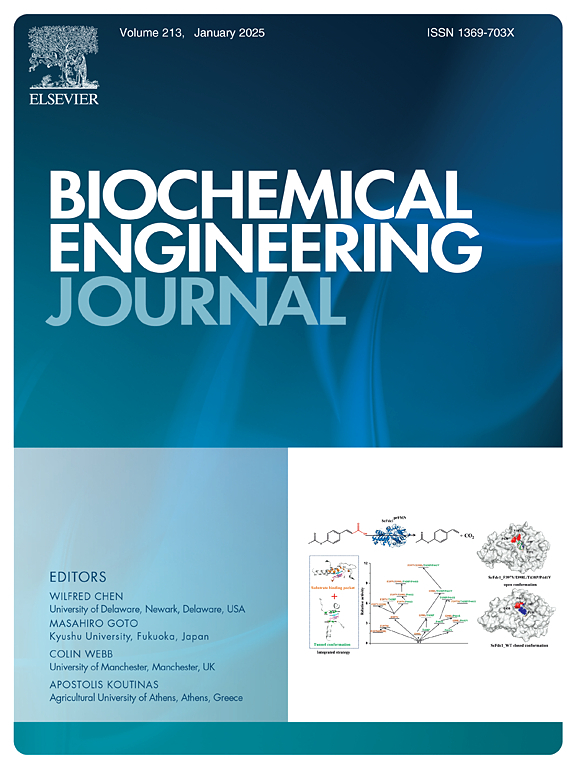Advanced anaerobic digestion by co-immobilization of anaerobic microbes and conductive particles in hydrogel for enhanced methane production performance
IF 3.7
3区 生物学
Q2 BIOTECHNOLOGY & APPLIED MICROBIOLOGY
引用次数: 0
Abstract
Recent research has increasingly focused on the enhancement of anaerobic digestion (AD) through direct interspecies electron transfer (DIET) facilitated by conductive particles (CP). Although this approach can significantly accelerate the AD process, the contact efficiency between CPs and AD microbes is relatively low due to the flow of water in a dispersed condition, leading to possible DIET inefficiency. In this study, a unique approach involving the “co-immobilization” of anaerobic microbes and multi-walled carbon nanotubes (MWCNTs) as CP into a hydrogel matrix was developed to improve the AD process. The advantages of this method include improved contact efficiency between microbes and CPs for enhanced DIET, and increased CP retention within the reactor, thereby omitting the need to compensate for CP washout. The methane production rate for the co-immobilized hydrogel was 2.5-fold and 1.9-fold faster than that of the control (dispersed sludge) and conventional DIET (dispersed sludge with MWCNT addition), respectively. Microbial analysis indicated the enrichment of functional microbes such as Anaerolineacea, Sedimentibacteraceae, Rhodocyclaceae, and Methanothrichaceae, which could be involved in the DIET under co-immobilized conditions. These results demonstrate the potential of the proposed method for realizing an advanced continuous AD process through improved DIET.
通过将厌氧微生物和导电颗粒共同固定在水凝胶中实现高级厌氧消化,从而提高甲烷生产性能
最近的研究越来越关注通过导电颗粒(CP)促进种间直接电子传递(DIET)来提高厌氧消化(AD)的效果。虽然这种方法可以大大加快厌氧消化过程,但由于水流处于分散状态,CP 与厌氧消化微生物之间的接触效率相对较低,可能导致 DIET 效率低下。本研究开发了一种独特的方法,将厌氧微生物和作为 CP 的多壁碳纳米管(MWCNTs)"共同固定 "到水凝胶基质中,以改进厌氧消化工艺。这种方法的优点包括提高微生物与氯化石蜡之间的接触效率,从而增强 DIET,并增加氯化石蜡在反应器中的保留率,从而无需补偿氯化石蜡的冲刷。与对照组(分散污泥)和传统 DIET(添加了 MWCNT 的分散污泥)相比,共固定水凝胶的甲烷生产率分别提高了 2.5 倍和 1.9 倍。微生物分析表明,Anaerolineacea、Sedimentibacteraceae、Rhodocyclaceae 和 Methanothrichaceae 等功能微生物富集,它们可能参与共同固定条件下的 DIET。这些结果表明,所提出的方法具有通过改进 DIET 实现先进的连续厌氧消化(AD)工艺的潜力。
本文章由计算机程序翻译,如有差异,请以英文原文为准。
求助全文
约1分钟内获得全文
求助全文
来源期刊

Biochemical Engineering Journal
工程技术-工程:化工
CiteScore
7.10
自引率
5.10%
发文量
380
审稿时长
34 days
期刊介绍:
The Biochemical Engineering Journal aims to promote progress in the crucial chemical engineering aspects of the development of biological processes associated with everything from raw materials preparation to product recovery relevant to industries as diverse as medical/healthcare, industrial biotechnology, and environmental biotechnology.
The Journal welcomes full length original research papers, short communications, and review papers* in the following research fields:
Biocatalysis (enzyme or microbial) and biotransformations, including immobilized biocatalyst preparation and kinetics
Biosensors and Biodevices including biofabrication and novel fuel cell development
Bioseparations including scale-up and protein refolding/renaturation
Environmental Bioengineering including bioconversion, bioremediation, and microbial fuel cells
Bioreactor Systems including characterization, optimization and scale-up
Bioresources and Biorefinery Engineering including biomass conversion, biofuels, bioenergy, and optimization
Industrial Biotechnology including specialty chemicals, platform chemicals and neutraceuticals
Biomaterials and Tissue Engineering including bioartificial organs, cell encapsulation, and controlled release
Cell Culture Engineering (plant, animal or insect cells) including viral vectors, monoclonal antibodies, recombinant proteins, vaccines, and secondary metabolites
Cell Therapies and Stem Cells including pluripotent, mesenchymal and hematopoietic stem cells; immunotherapies; tissue-specific differentiation; and cryopreservation
Metabolic Engineering, Systems and Synthetic Biology including OMICS, bioinformatics, in silico biology, and metabolic flux analysis
Protein Engineering including enzyme engineering and directed evolution.
 求助内容:
求助内容: 应助结果提醒方式:
应助结果提醒方式:


